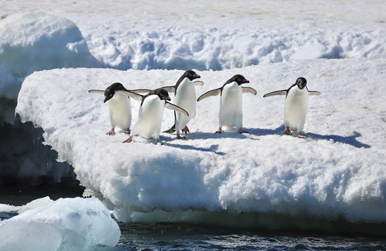
Even before he graduated with a degree in journalism, Gabe Castro-Root, SOC/BA ’25, had chased down a story few reporters will.
In December, the Northern California native set sail as the lone student journalist on the Future of Space organization’s inaugural Space2Sea expedition to Antarctica. Like a breaching whale, Castro-Root jumped at the once-in-a-lifetime opportunity to document Earth’s final frontier, joining a small media crew aboard the 10-story Seabourn Venture. Passengers also included astrophysicist Neil deGrasse Tyson, NASA astronaut Scott Kelly, ocean conservationist Celine Cousteau, and Star Trek actor William Shatner.
“I figured I’d get to Antarctica—maybe—when I retire,” says Castro-Root, who has now been to all seven continents. “After the trip, my friends were like, ‘You’ve peaked—it’s all downhill from here.’
“I hope that’s not true,” he says with a smile.
Antarctica—larger than the United States and Mexico combined—is perhaps the most remote and beautiful place on the planet. But along with the North Pole, it’s the most vulnerable to climate change. Since the 1970s, the Southern Ocean has absorbed up to 75 percent of the excess heat created by humans and 40 percent of the carbon dioxide. NASA estimates that the continent is losing ice mass at an average rate of 150 billion metric tons per year.
During the 10-day expedition, which set sail from Ushuaia, Argentina, Castro-Root explored breathtakingly massive glaciers and towering mountains. He learned about Antarctica’s rich industrial history and the groundbreaking work being undertaken by scientists at about 50 research stations. And he spent hours aboard an inflatable Zodiac boat, training the lens of his Canon EOS 6D Mark II camera on penguins, whales, and seals—the most visible species in the continent’s vibrant yet mysterious ecosystem.
Castro-Root’s favorite image (pictured) features five Adélie penguins peering into the frigid water from a sheet of ice. “They moved so quickly,” Castro-Root says. “I was lucky to get [a photo] where all of them had their eyes open.”
Castro-Root, who in June began a prestigious yearlong fellowship on The New York Times travel desk, journaled religiously on the trip and published several articles upon his return. His bylines include a Smithsonian magazine piece about the big benefits of tiny Antarctic krill and a Space.com story about two Ukrainian soldiers who fulfilled their lifelong dream of visiting the White Continent after spending a year in Russian captivity.
“I’ve been fortunate to go to a lot of places that are beautiful and inspiring, but there’s nothing that really comes close to Antarctica,” Castro-Root says. “It’s so different from anywhere else on the planet, and we saw only a f raction of what’s there. I feel like I could go back to Antarctica 100 times.”
The former Eagle editor—who interned at the San Francisco Chronicle, Bloomberg Law, and the School of Communication’s Investigative Reporting Workshop—earned his spot on the Seabourn Venture through an SOC essay contest. Emmy Award-winning journalist Antoine Sanfuentes, CAS/BA ’89, media consultant and former vice president and managing editor of CNN’s Washington bureau, helped forge the connection between SOC and Future of Space.
Sanfuentes, who accompanied Castro-Root on the journey, saw the partnership as way to pay it forward to the next generation of reporters. Early in his career at NBC News, Sanfuentes worked—and learned—alongside Brian Williams, Tim Russert, Chuck Todd, and more.
“To be a journalist, you can’t go it alone,” says Sanfuentes, who spent 24 years at NBC News, the last two of them as senior vice president and managing editor. “I immediately thought someone with Gabe’s talent could find themselves in a place like Antarctica.”
Sanfuentes, who has taught several classes as an SOC guest lecturer, says that now that Castro-Root has explored—and reported from—the bottom of the Earth, the sky’s the limit for his career.
The New York Times “hired a rock star who is newsroom-ready,” Sanfuentes says. Castro-Root is someone “they could send into the field or to the outer reaches of this Earth, who would deliver in incredible ways.”